Operations
Description
Detect, deter and defend against threats to or attacks on Canada. Assist civil authorities and law enforcement, including counter-terrorism, in support of national security, domestic disasters or major emergencies, and conduct Search and Rescue (SAR) operations.
Detect, deter and defend against threats to or attacks on North America in partnership with the United States, including through North American Aerospace Defence Command (NORAD).
Lead and/or contribute forces to North Atlantic Treaty Organization (NATO) and coalition efforts to deter and defeat adversaries, including terrorists, to support global stability. Lead and/or contribute to international peace operations and stabilization missions with the United Nations, NATO and other multilateral partners. Engage in capacity building to support the security of other nations and their ability to contribute to security and the security of Canadians abroad while adhering to Canadian standards on Human Rights and the Law of Armed Conflict. Assist civil authorities and non-governmental partners in responding to international and domestic disasters or major emergencies.
Planning highlights
To achieve Canada’s defence objectives, the Canadian Armed Forces (CAF) must be able to undertake its eight core missions, as set out in Strong, Secure, Engaged: Canada’s Defence Policy, to ensure that Canada remains Strong at home, Secure in North America and Engaged in the world.
The CAF will respond to domestic, continental, and international threats, and anticipate, adapt, and posture for concurrent operations, in support of Government of Canada objectives. This includes defence and security elements of Canada’s Indo-Pacific Strategy, which includes opportunities to increase CAF presence, collect and share intelligence, and deepen defence partnerships in the Indo-Pacific region.
The CAF balances risk between the demands of force employment and force generation. Since 2020, there continues to be significant increase in pressure to support contingency domestic operations, respond to requests for assistance from civil authorities and non-governmental partners, and address the ongoing impacts of COVID-19 on the workforce. This has stressed CAF capabilities and creates challenges towards managing the demands of force employment and force generation.
In FY 2023-24, the CAF will examine opportunities for defence activities to be consolidated, divested or paused to generate capacity savings and reduce staffing pressures.
The CAF will leverage operational experience to learn from every action and mission to improve and inform force generation and development, while maintaining oversight on the day-to-day management of operations. The Defence Team will identify clear desired effects, objectives, and performance metrics to inform operational assessments that will allow the CAF to measure success, and will identify and make the necessary adjustments, as required, in a timely manner. In addition to increased efforts to synchronize and optimize efforts on a regional scale, the attention paid to ongoing and emerging missions will remain steadfast while achieving economies of effort.
DND/CAF will enhance its abilities to collect, analyze, and share intelligence in order to detect, recognize, and understand threats in all domains and position ourselves to address a constantly evolving threat environment. DND/CAF will develop and expand its intelligence networks abroad to ensure rapid and timely collection, processing, and exchange of information.
Canada and its allies face increasingly dangerous competition from malign and hostile rival powers. Governed by autocratic leaders, these powers aspire to redefine the existing international rules-based order and undermine core Canadian and allied interests, specifically to security, prosperity, democratic institutions and political independence. To address these challenges, the Department of National Defence (DND)/CAF will continue to enhance operations across all domains and will further define the CAF’s functional approach to compete with, contest, confront, and, when necessary, combat Canada’s adversaries.
OPERATION NOBLE DEFENDER 23-1.1
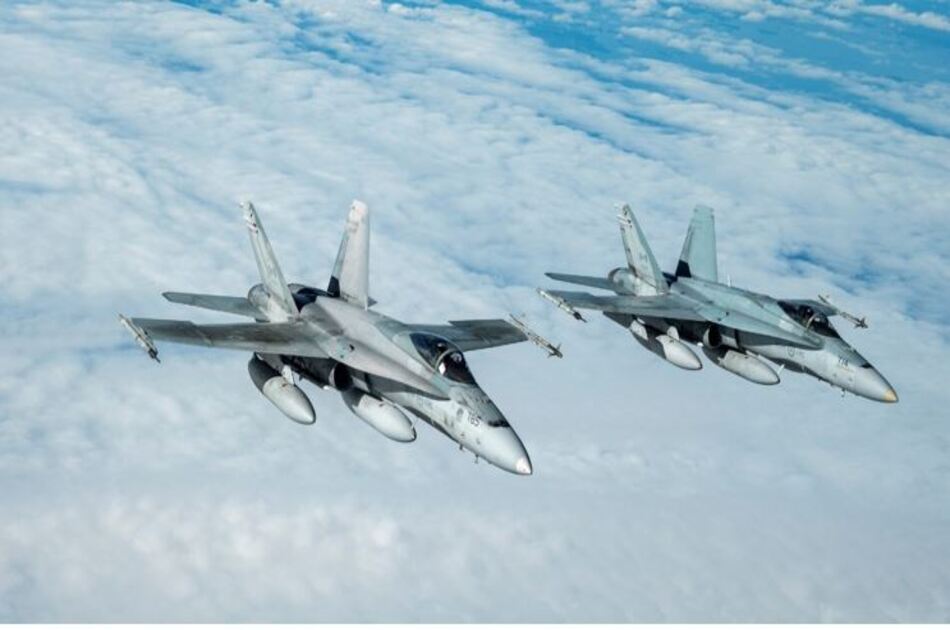
Under the direction of the NORAD, two CF-18s assigned to the Royal Canadian Air Force flies to the Pennsylvania Air National Guard during air-defense Operation NOBLE DEFENDER, October 27, 2022.
Photo: United States Air National Guard Photo by Technical Sergeant Bryan Hoover.
Defence will assume an assertive posture in the cyber domain to ensure our ability to defend, as well as improve the capability to conduct active cyber operations against potential adversaries in the context of government-authorized military missions. DND/CAF will:
- Continue, with Communications Security Establishment, the unified development of active cyber operations capabilities on behalf of the Government of Canada. Under a unified leadership and management structure, highly skilled cyber operators will work together to assume a more assertive posture in the cyber domain by conducting and supporting joint cyber operations;
- Develop a refined Cyber Event Management process that streamlines response coordination internally and with other agencies. In addition, Defence is developing Cyber Protection Conditions that link threat identification with defensive measures;
- Advance capabilities, capacity and expertise to support deployed operations in a contested cyber environment;
- Maintain the stability, integrity, and availability of Information Management (IM)/Information Technology (IT) capabilities that support critical services and operations within the department; and
- Work with Government of Canada partners to ensure Information Management/Information Technology solutions are secure, resilient, and recoverable from incidents in a timely manner so as not to impact the operations of the department.
Planned Costs for Major Canadian Armed Forces Operations and information on current CAF operations and exercises are available on the Department of National Defence and the Canadian Armed Forces’ website.
Gender-based analysis plus (GBA Plus)
The Defence Team uses GBA Plus in the planning and conduct of all our operations. The Defence Team maintains full-time Gender Advisors and part-time Gender Focal Points in every named operation to advise commanders and staff on the conduct of GBA Plus and in the use of findings in the planning and execution of all our operations with expert support from Director Gender Equality and Intersection Analysis. Further, all deployed personnel complete training to continue to integrate GBA Plus and the Women Peace and Security agenda into current and planned operations and exercises. Integrating gender perspectives into the planning and conduct of operations increases our understanding of the effects of operations on vulnerable groups, improves our situational and cultural awareness, and ensures we are cognizant of the gender considerations that support mission success.
The Defence Team will continue to expand the network of full-time Gender Advisors and part-time Gender Focal Points to support the conduct of GBA Plus in the planning and conduct of our operations and further incorporate gender analysis and gender perspectives into pre-deployment training for CAF personnel and DND employees, as well as into training offered to partners and allies. In addition, job-specific training will continue to be developed and updated to enhance the ability and capacity of planners and operators.
As part of efforts to modernize NORAD and strengthen continental defence, Defence will continue to work throughout the policy development process in order to ensure that GBA Plus considerations are captured and that gender and intersectional perspectives are integrated into the proposals and advice being developed for Government consideration. With Northern initiatives and investments expected to be critical to fulfilling this commitment, DND/CAF will continue this work to ensure that continental defence efforts are underpinned by meaningful dialogue with key stakeholders, including Northern and Indigenous partners, to ensure that various viewpoints and priorities are incorporated into this work. DND/CAF will take a distinctions-based, nation-to-nation approach to engagement and consultation throughout this process.
In relation to policy support to operations, Defence recognizes that diversity of representation in peacekeeping improves overall performance, provides for greater access to communities, helps in promoting human rights and the protection of civilians, and encourages equality-seeking groups to become a meaningful part of peace and political processes. Canada supports the United Nations in its efforts to increase women’s meaningful participation in uniformed roles in peace support operations, both through the Elsie Initiative, and through our own deployments.
More information on GBA Plus can be found in the “GBA Plus Supplementary Information Table” in Supplementary information tables section of this report.
Experimentation
In FY 2022-23, NORAD will continue its rapid development effort in support of its information domain and decision superiority strategic priorities. Continued effort will be pursued to advance the Pathfinder capability beyond the Minimum Viable Package that was delivered in fall of 2021. Moreover, NORAD will, in coordination with United States Northern Command (USNORTHCOM), continue to support the Global Information Domain Experiment in order to advance the integration of Artificial Intelligence (AI) and Machine Learning in support of decision making.
In FY 2022-23, DND/CAF will continue its experimentation efforts to improve operations, including through two key initiatives: Multi Domain Command and Control Concept Development and Experimentation and Coalition Warrior Interoperability eXperiment. Multi Domain Command and Control Concept Development and Experimentation will develop innovative solutions to help evolve CAF planning and Command and Control (C2) for the conduct of Multi Domain Campaigning. In support of this, Coalition Warrior Interoperability Experiment will explore methods of improving information-sharing capabilities and C2 functions between NATO, allies and select non-NATO entities. This will assist with the development of concepts, organizational designs, and doctrine for assigned joint challenges.
Additional defence-related experimentation activities are outlined in this report under Core Responsibility 4 – Future Force Design.
Key Corporate Risk(s)
There are many risks associated with the Operations Core Responsibility. Two of the Key Corporate Risks directly associated with Operations are articulated below:
Physical Environment – There is a risk that changes to the physical environment of Canada and the world, including changes due to climate change, will impact the type, frequency and conduct of DND/CAF activities.
Cyber Intrusion – There is a risk of serious harm (e.g. loss of sensitive data, disruption to the network, physical electronic damage, loss of confidence in institution/reputation, etc.) resulting from a cyber intrusion.
The risks above can affect the department’s ability to achieve the Departmental Results of the Operations Core Responsibility.
As the Defence Departmental Results Framework reflects a chain of delivery from conceiving of the required armed forces, to developing them and then executing operations, the activities to mitigate the risks to Operations can also be found in other Core Responsibilities which deliver building blocks that enable the results of Operations.
Departmental Result 1.1 – Canadians are protected against threats to and attacks on Canada
The CAF, in cooperation with NORAD and USNORTHCOM, will continue to detect, deter and defend against threats to Canada and North America and will be prepared to support provincial and territorial authorities in response to natural disasters.
Information from several domains is used to maintain continuous watch over land, sea, air, space, and cyber domains. The CAF will build on JISR capabilities to improve our detection activities, along with other national initiatives, to detect threats to Canada. With better detection abilities, any threats to Canadians and Canadian interests could then be deterred and degraded through a whole-of-government approach. Specific contingency plans to address threats to Canada include NORAD CONPLANS, Operation LIMPID, Operation LASER, Operation LENTUS, and the Standing Operations Order for Domestic Operations. Further, DND/CAF will protect Canadians from threats by:
- Responding to Requests for Assistance, as directed by the Government of Canada, for a range of domestic emergencies by providing military support;
- Responding to Requests for Assistance on an as-needed basis and only at the request of the provincial authority through the Minister of Public Safety. Of note, the CAF must remain the force of last resort to respond to these emergencies by:
- Responding to the impact of a worldwide pandemic situation (Operation LASER) and providing support for civilian authorities to ensure the transportation, delivery and administration of COVID-19 vaccines to Canadians (Operation VECTOR); and
- Responding to provincial requests for disaster response assistance (Operation LENTUS).
- Conducting Operation LIMPID to detect threats to Canada by enhancing awareness of maritime, land and aerospace domains;
- Strengthening our collaboration with and support to other government departments and agencies in order to maintain a cooperative National Security community by increasing and improving communication and coordination efforts, primarily through personnel exchanges and continuous communication;
- Conducting operational-level engagement with other government departments and agencies in order to enhance interoperability and mutual support as outlined in the Federal Emergency Response Plan and in support of CAF operations. Liaison officers are co-located at the Government Operations Centre and the Royal Canadian Mounted Police (RCMP);
- Working with other authorities and agencies in support of Law Enforcement and National Security. Ongoing operations include support for Parks Canada for avalanche control (Operation PALACI); and
- Continuing to develop capabilities, capacity and expertise to conduct active cyber operations in response to threats and attacks.
Operation VECTOR

Members of the Land Task Force support a COVID-19 vaccination clinic for the second dose in Nisichawayasihk Cree Nation, Manitoba during Operation VECTOR on 7 May, 2021.
(Photo Credit: Corporal Genevieve Lapointe, Canadian Forces Combat Camera)
As noted above, the department continues to develop capabilities and capacity for conducting active cyber operations to detect, deter and defend against threats to Canada and in support of CAF operations. We continue to work with Government of Canada colleagues mandated to provide cyber security across the government, ensuring our combined cyber capabilities are aligned. The department is enhancing its ability to defend DND systems and networks through the strengthening of relationships with key Government of Canada stakeholders such as the Canadian Centre for Cyber Security.
DND/CAF and Communications Security Establishment are working together to conduct and support joint cyber operations against adversaries who wish to threaten Canada’s national interests. For its part, DND/CAF derives authority from exercises of the Crown Prerogative, and through the National Defence Act, to conduct active cyber operations in the context of government-authorized military missions. Active cyber operations are subject to all applicable domestic law, international law, rules of engagement, formal targeting processes, and collateral damage assessments.
The Canadian Special Operations Forces Command (CANSOFCOM) will remain postured to identify, confront and defeat threats to Canadians and Canadian interests at home and abroad through its ability to integrate special operations forces effects, both within the inter-agency domain and through strengthened collaboration with whole-of government partners.
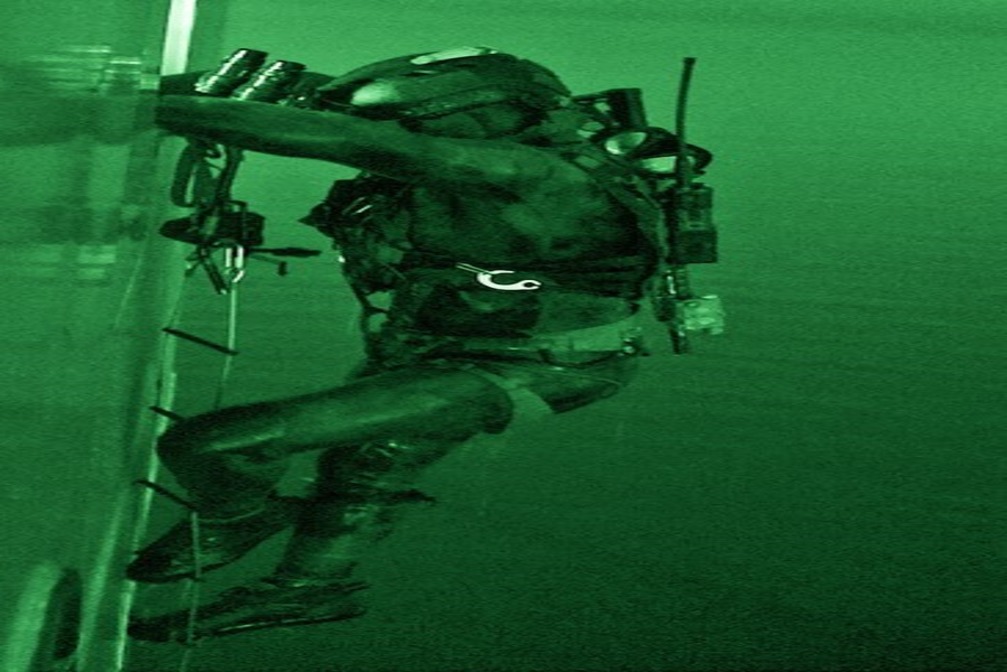
A member of CANSOFCOM conducts training in British Columbia, September 2021.
(Photo Credit: CANSOFCOM Imaging)
Planned results
| Departmental Results | Departmental Result Indicators | Target | Date to achieve target | 2018–19 Actual results | 2019–20 Actual results | 2020–21 Actual results |
|---|---|---|---|---|---|---|
| 1.1 Canadians are protected against threats to and attacks on Canada | % of requests for assistance that are fulfilled | 100% | 31 March 2023 | 100% | 100% | 100%* |
| % of force elements that are deployed within established timelines | 100% | 31 March 2023 | 100% |
100% | 100% | |
| % of stated objectives met by domestic operations | 100% | 31 March 2023 | 92% | 98% | 95%** | |
| Extent to which the Canadian Armed Forces is effective in domestic operations | The Canadian Armed Forces is effective in the conduct of domestic operations | 31 March 2023 | Not available qualitative indicator as of 2019-20 | This is a qualitative indicator*** | This is a qualitative indicator**** |
Notes:
* CAF support was provided in a timely manner to respond to all tasked Requests for Assistance (RFAs). Furthermore, the CAF terminated the support only when all transition criteria were met.
** Canadian Armed Forces (CAF) domestic operations demonstrated success in the overall process to act on the influx of RFA from our civilian counterparts. Our centre of gravity, domestically, is unity of purpose with Other Governmental Departments and Agencies, and bilateral operational partners which we develop, define and foster through a shared understanding of the defence, safety and security environment. Moving forward, it should be noted that capability requirements, resources and interoperability continue to require refinement from all parties involved, in order to meet stated objectives. COVID-19, along with a number of exacerbating operational factors, has hampered to some degree the ability to project operational impacts and achieve desired stated objectives. The remaining 5% corresponds to known capability deficiencies that are being addressed through the Defence Investment Plan.
*** The CAF benefitted this year from streamlined response times and improved whole-of-government efforts, especially for responses to Requests for Assistance (RFA) from provincial emergency management response centres. Although capability deficiencies, resource limitations and interoperability challenges persist for domestic operations, the CAF are still able to mitigate challenges to meet operational requirements. Moving forward, by working together with industry, academics and other partners, the CAF will continue to improve its capabilities, including: Surveillance assets used during Fishery Patrols, Search & Rescue and CAF response to fires, floods and natural disasters; Cyber tools for defence; Space assets in support of Operation LIMPID and NANOOK; alternative fuels; Remotely Piloted Systems; Data Analytics; and, Mental Health and Operational Stress Injury support. Further described successes and challenges can be found throughout Departmental Results 1.1 of the 2019-20 Departmental Results Report.
**** The CAF provided support to civilian organizations in response to a range of crises, including: humanitarian crises and COVID-19 response. In the FY 2020-21, Operations LASER and VECTOR were activated in order to aid the Canadian public and regional authorities. All operations were handled effectively, deploying members within 24 hours upon operation approval, and delivered through to conclusion or handover to an appropriate agency. The CAF deployed 100% of the identified personnel. Capability enhancement initiatives, such as the All Domain Situational Awareness Science and Technology Program, seek to resolve challenges in the Arctic due to existing communication and Joint Intelligence, Surveillance and Reconnaissance (ISR) deficiencies impacting interoperability with partners and other governmental departments. Further described successes and challenges can be found throughout Departmental Results 1.1 of the 2020-21 Departmental Results Report.
Financial, human resources and performance information for the Department of National Defence and the Canadian Armed Forces’ Program Inventory is available in the GC InfoBase.
Operation LENTUS: Mudslide, Merritt, British Columbia
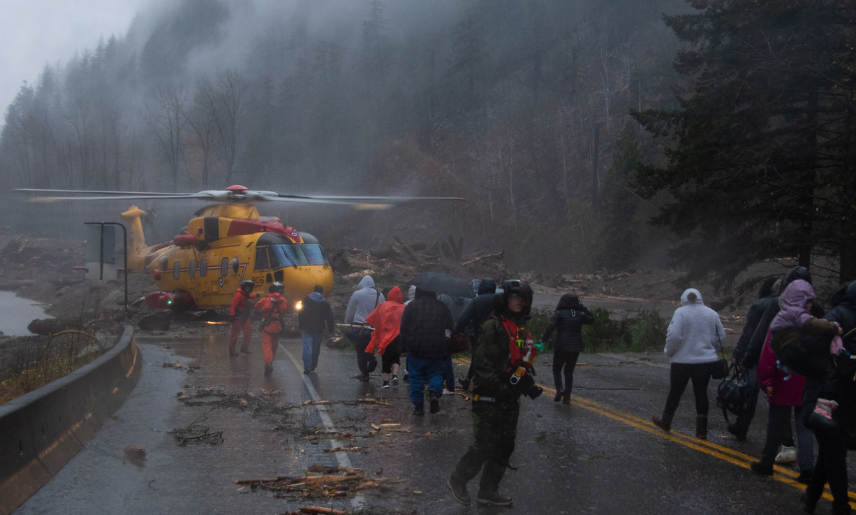
A CH-149 Cormorant and its crew from 442 Search and Rescue Squadron provide support for Operation LENTUS, evacuating people out of Merritt, British Columbia, after heavy rain triggered mudslides along a British Columbia highway on 15 November 2021.
(Photo Credit: Corporal Parker Salustro, CAF Photo)
Departmental Result 1.2 – People in distress receive effective search and rescue response
SAR is a shared responsibility. Many partners are involved because of the country’s immense size, range of terrain and weather. The list of partners is made up of government, military, volunteer and industry groups. They all work together to provide SAR services across the nation. This is known as the National Search and Rescue Program.
The CAF remains focused on our primary responsibilities of providing aeronautical SAR and coordinating the aeronautical and maritime SAR system. CAF SAR crews are on standby 24 hours a day, 7 days a week.
Searches for missing persons, including Ground Search and Rescue, are a provincial and territorial responsibility, often delegated to the police service with jurisdiction. The provincial, territorial or municipal authority have the responsibility to request CAF assistance when required. The CAF, which includes Canadian Rangers and Primary Reserve members, will assist in Ground Search and Rescue efforts when authorized.
Planned results
| Departmental Results | Departmental Result Indicators | Target | Date to achieve target | 2018–19 Actual results | 2019–20 Actual results | 2020–21 Actual results |
|---|---|---|---|---|---|---|
| 1.2 People in distress receive effective search and rescue response | % of coordinated maritime, aeronautical and joint response to search and rescue incidents deemed effective | 100% | 31 March 2023 | 100% | 100% | 100%* |
| % of requests for Canadian Armed Forces aeronautical search and rescue assistance that are fulfilled | 100% | 31 March 2023 | 100% |
100% | 100%** | |
| % of Canadian Armed Forces aeronautical search and rescue operations that meet established standards | 100% | 31 March 2023 | 95.2% |
85% | 91%*** |
Notes:
* There were 8809 Search and Rescue (SAR) incidents (cases), with 1 821 cases having a final classification of 1 (Distress) or 2 (Imminent Distress). All Joint Rescue Coordination Centre SAR cases were handled effectively and delivered through to conclusion or handed over to an appropriate agency.
** The 8809 cases generated 648 SAR taskings for the Royal Canadian Air Force air assets. In the other cases, Joint Rescue Coordination Centres utilized assets of opportunity, including civilian aircraft and vessels that were available to resolve cases quickly and efficiently when safe and appropriate to do so.
*** Of the 648 times tasked, the CAF met their response timeline in 592 cases; therefore, 91% of the time. There are many circumstances which determine how a tasked SAR unit responds and therefore whether the response timeline can be met. Inclement weather and time to load additional fuel for long, extended missions are the main causes for delays. SAR mission coordinators used every tool at their disposal to ensure all responses to SAR incidents in Canada are effectively conducted and/or coordinated to conclusion, or to handover to an appropriate agency.
Financial, human resources and performance information for the Department of National Defence and the Canadian Armed Forces’ Program Inventory is available in the GC InfoBase.
Departmental Result 1.3 – Canada’s Arctic sovereignty is preserved and safeguarded
The CAF maintains a year-round presence in Canada’s North and routinely conducts training and operations in the region. In support of this, the activities conducted as part of the Arctic Campaign Plan will enhance Canadian presence and ensure the defence, security, and safety of Canada’s Arctic and Northern regions.
The Canadian Rangers, an integral component of the CAF, are a diverse and agile capability able to provide assistance to the government of Canada in sparsely settled remote, northern, coastal and isolated areas.
NORAD regularly conducts exercises and operations in the Arctic that cover a range of scenarios to ensure the CAF is ready to respond to a full spectrum of threats. Operation NOBLE DEFENDER and Exercise AMALGAM DART events demonstrate agile and dynamic force employment along the northern approaches to North America. In addition, Exercise VIGILANT SHIELD, an annual homeland defence exercise demonstrates readiness and ability to defend Canada and the United States.
The Arctic, which has long been a priority for Canada, has become increasingly accessible as a result of climate change and technological advances. This has made the region strategically important, attractive and profitable for a greater number of non-traditional Arctic countries, including competitors. Thus, the importance for the CAF to be able to exert presence and operate effectively in the Arctic is increasing, in order to contribute to Canadian sovereignty in the North.
Exercise AMALGAM DART 21-2
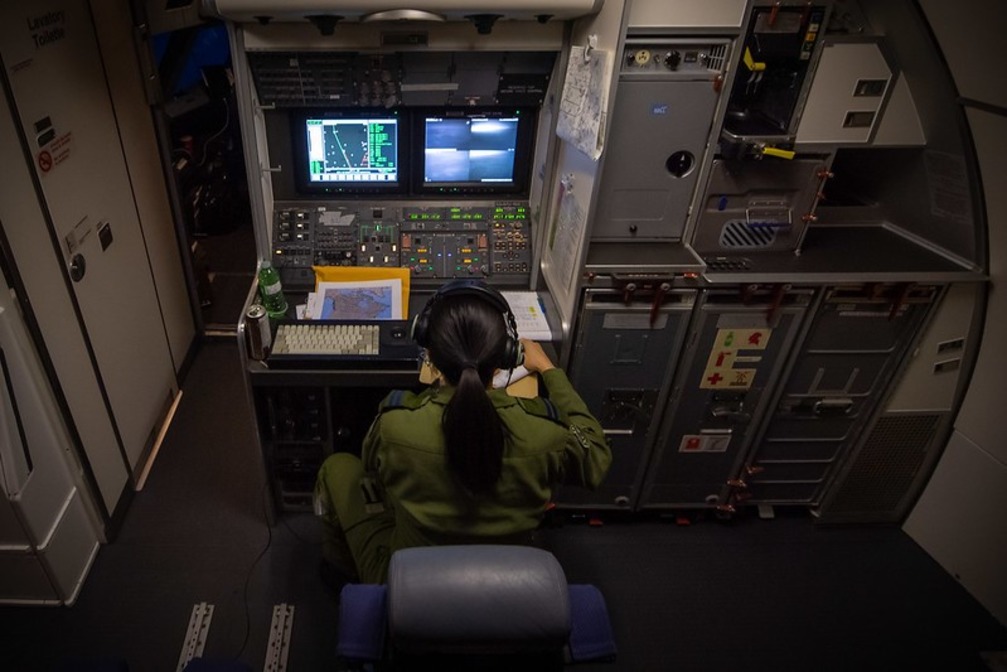
Air Combat Systems Officer, Captain Katie Fung from 437 Transport Squadron in Trenton, Ontario, coordinates the air-to-air refueling operations over the Canadian Arctic between a CC-150 Polaris Airbus and two CF-18 Hornets from 401 Tactical Fighter Squadron in Cold Lake, Alberta, during the NORAD Exercise AMALGAM DART 21-2, on 23 March 2021.
(Photo Credit: Master Corporal PJ Letourneau, Canadian Forces Combat Camera)
The CAF will enhance and expand the Defence northern footprint, while increasing capabilities in surveillance, mobility and training in Canada’s North, in order to enhance the CAF’s ability to operate in the Arctic and adapt to a changed security environment. Arctic communities are the most present and enduring expression of Canada’s sovereignty; therefore, consultation with Northern communities on military activities in the Arctic is important.
In FY 2022-23, plans include:
- Improving mobility and enhancing surveillance capabilities in Canada’s North. Joint Arctic Experiments are planned for JISR, Satellites, Underwater Sensors, Underwater Autonomous Vehicles, Shelter Systems, Autonomous Surface Vehicles and Human Factors and Cold Weather Injuries;
- Operation NANOOK: Operation NANOOK is a strategic demonstration of ability and resolve, while tactically, it is a training opportunity for all involved. Operation NANOOK activities for FY 2022-23 will include:
- Conducting an inter-agency exercise collaboratively planned and executed by Joint Task Force North and its northern partners;
- Conducting a multinational maritime exercise led by the Royal Canadian Navy (RCN);
- Exercising domain presence, surveillance and awareness over Canada’s northernmost regions supported by Canadian Rangers; and
- Projecting and sustaining forces in a high Arctic environment in a combined-joint security context.
- Advancing interoperability, situational awareness and information-sharing initiatives through continuing collaboration with NORAD; and, advancing interoperability and information sharing with allies and partners in USNORTHCOM, NATO engagements, the Arctic Security Forces Roundtable, the Arctic Security Working Group and the Arctic Capabilities Advisory Working Group;
- Improving surveillance and control in the Arctic. Defence will expand pan-domain awareness in the Arctic in support of continental defence and NORAD missions through innovative options for Northern Approaches Surveillance. This includes, but is not limited to, the renewal of the North Warning System and delivering on the All Domain Situational Awareness Executive Group mandate to deliver on advance means of ensuring Canadian awareness of the Arctic and maritime approaches to Canada. DND/CAF will continue to collaborate with the United States to develop new technologies and capabilities that will provide surveillance and detection capabilities against pan-domain threats at a range that allows decision makers to operate at the speed of relevance;
- The Defence Team will remain an effective capability-building partner by helping other government departments and agencies, as well as territorial and Indigenous governments, to fulfill their mandates when authorized. We continue to increase our familiarity with and situational awareness of Arctic activities and carry out successful CAF operations in harsh operating environments, including through Operation LIMPID; and
- Efforts will continue to be made to consult and work with Northern Indigenous communities when opportunities for contracting, procurement or socio-economic support exist.
Operation NANOOK-NUNALIVUT
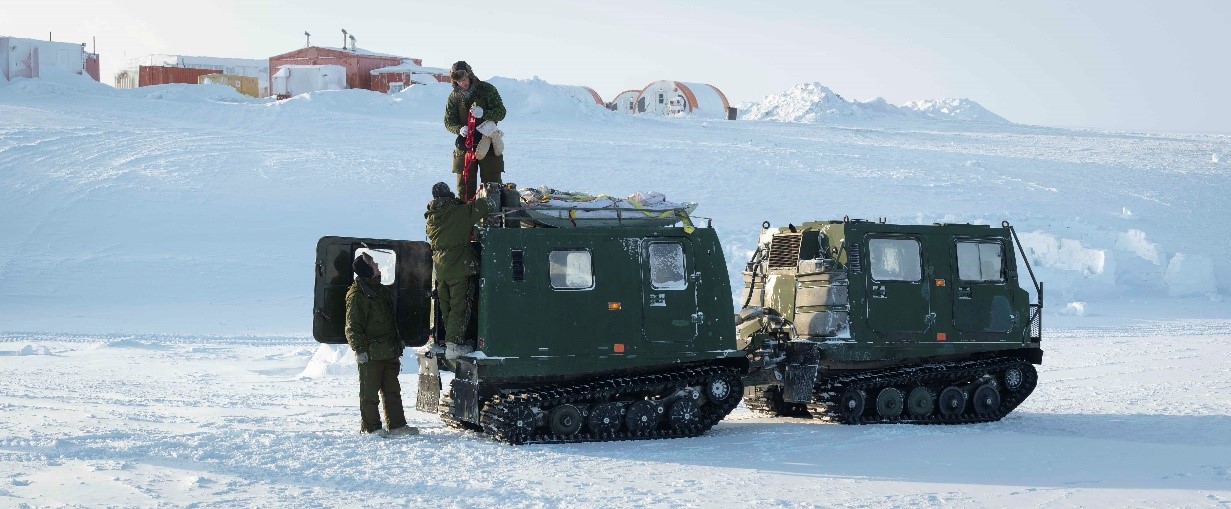
Canadian Armed Forces members deployed on Operation NANOOK-NUNALIVUT do reconnaissance of Crystal City, Nunavut on 7 March, 2020.
(Photo Credit: CAF photo)
The CAF anticipates that climate change will increasingly impact the safety, security, and livelihoods of Northerners, threaten critical defence infrastructure, and bring added demands to support domestic emergency response and search and rescue operations.
The Arctic region is of great strategic importance for continental defence. Increasing the CAF’s presence in the Arctic, improving Arctic surveillance, and strengthening rapid response capabilities will be critical to providing credible deterrence to new and emerging threats. To bolster the CAF’s capabilities in the Arctic, new investments will focus on infrastructure improvements, surveillance and C2 systems (to include associated Space segments) and the CH-147F Chinook Helicopter Extended Range and Forward Area Refuelling Minor Capital Project.
Operation NANOOK-NUNALIVUT
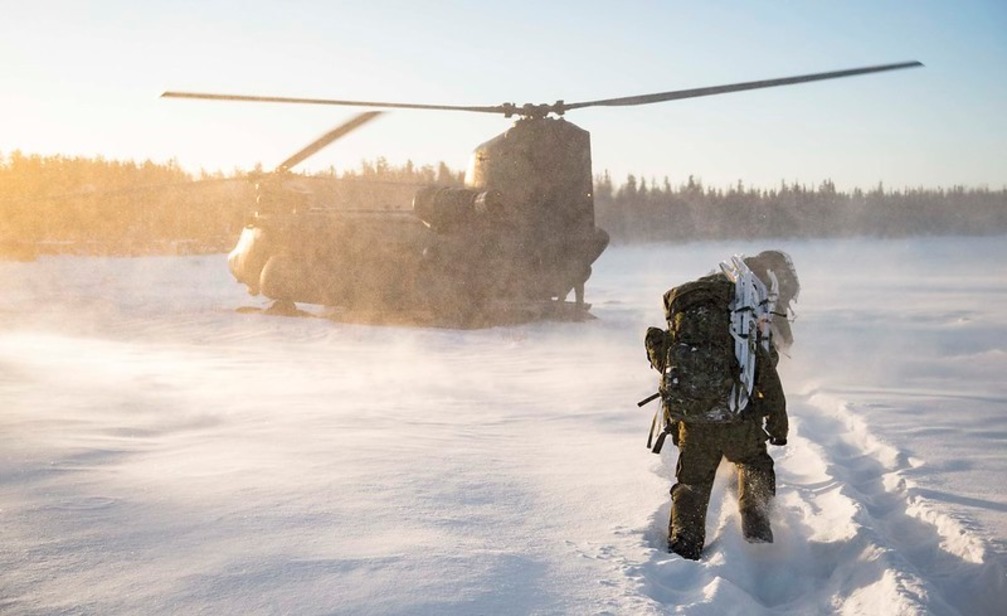
Soldiers from the 2nd Battalion, The Royal Newfoundland Regiment board a CH-147F Chinook helicopter in Yellowknife, Northwest Territories during the field portion of Operation NANOOK-NUNALIVUT on 3 March 2021.
(Photo Credit: Corporal Tori Lake, CAF photo)
In FY 2022-23, the CAF will review the Canadian Arctic Land Operating Concept – Northern Reaches to ensure it aligns with evolving policy guidance on the Arctic and Continental Defence. Northern Reaches is a supporting concept intended to provide specific contemporary guidance regarding operations in the region. It identifies some of the unique capabilities that Land Forces require in order to conduct tasks within the Canadian Arctic region and is intended to guide the Canadian Army (CA)’s capability development process with the aim of providing guidance on where preparations for such expeditionary Arctic operations might best be undertaken.
Support to CAF training at the CAF Arctic Training Centre (CAFATC) will continue. This infrastructure facilitates the delivery of individual training courses such as the Arctic Operations Course which is supported by Canadian Rangers and often has candidates from international partners such as the United States, the United Kingdom, and France. The Canadian Forces School of Search and Rescue and the Canadian Forces School of Survival and Aeromedical Training also train at the CAFATC. As required, the facility is also available to support yearly Arctic deployments (Operation NANOOK) that prepare CAF capabilities to operate in all environments.
Operation NANOOK-NUNAKPUT
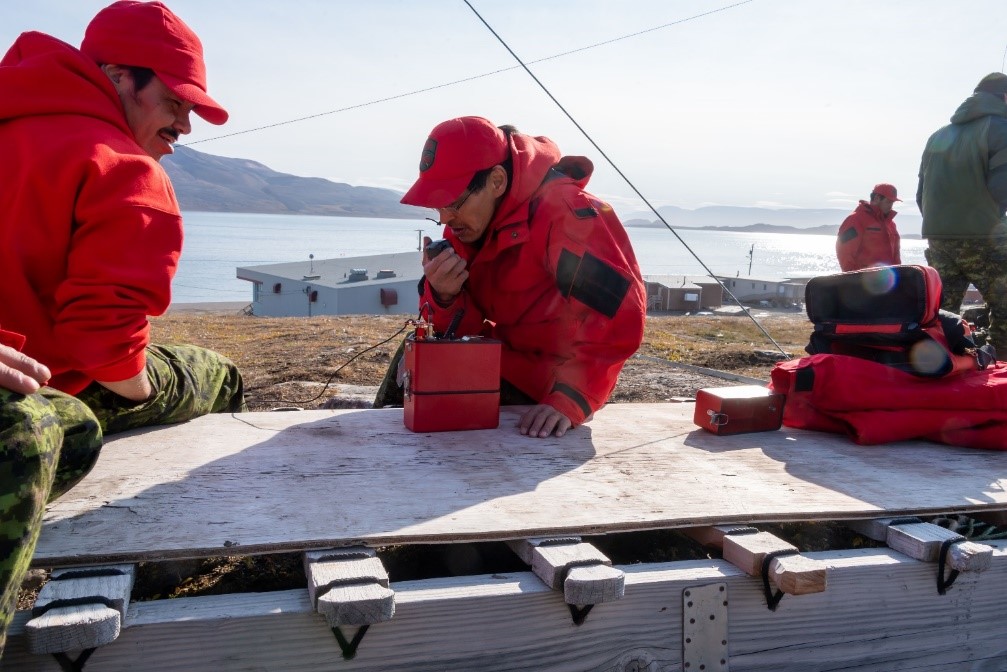
Members of 3rd Battalion, Princess Patricia’s Canadian Light Infantry (PPCLI) and Canadian Rangers practise radio set-up and procedure in Arctic Bay, Nunavut, as part of their training during Operation NANOOK-NUNAKPUT 21 on 23 August 2021.
(Photo Credit: Corporal Doug Burke, Visual Communications Support / JTFN, CAF photo)
Planned results
| Departmental Results | Departmental Result Indicators | Target | Date to achieve target | 2018–19 Actual results | 2019–20 Actual results | 2020–21 Actual results |
|---|---|---|---|---|---|---|
| 1.3 Canada’s Arctic sovereignty is preserved and safeguarded | % of stated objectives met by Arctic operations and exercises | 100% | 31 March 2023 | 100% | 100% | 95%* |
Notes:
* The Canadian Armed Forces (CAF) continued a year-round presence in Canada’s North. This presence continued to take the form of Joint Task Force (North), the CAF’s northern headquarters, and several exercises and sovereignty operations that were held in the Arctic. These activities shared the same purposes: to assert Canada’s sovereignty in the region, to strengthen CAF capabilities to conduct Arctic operations, and to improve the CAF’s ability to work with government partners in response to northern safety and security issues. Climate change will impact the nation’s ability to detect, deter, and degrade threats to Canadians and Canadian interests in the future, likely stressing the need for increased/improved resources specific to the Arctic. Interoperability deficiencies in existing communication systems between the CAF and other governmental departments caused a 5% decline in efficacy.
Financial, human resources and performance information for the Department of National Defence and the Canadian Armed Forces’ Program Inventory is available in the GC InfoBase.
Departmental Result 1.4 – North America is defended against threats and attacks
To ensure that North America is defended against threats and attacks, the CAF will position itself to employ conventional and special operations capabilities and collaborate with allies, regional partners and other Canadian government departments and agencies to deter, detect, confront and defeat pan-regional threats from nation states and violent extremist organizations.
DND/CAF will execute maritime warning, aerospace warning, and aerospace control missions in accordance with the NORAD Agreement and NORAD Terms of Reference. Maritime and aerospace warning and aerospace control missions involve the monitoring of aerospace and maritime activity from a continental perspective, while maintaining awareness, when authorized, in the land, space, cyber and information domains in order to detect and characterize threats against Canada or the United States to ensure that Canada is prepared to respond to threats.
NORAD seeks to adjust to the rapidly shifting global security environment and deter aggression by pursuing and employing a capable defence based on global integration, all-domain awareness, information dominance, and decision superiority. NORAD will leverage a wide array of capabilities, authorities, and activities to defend North America using means that currently exist in the command, and where necessary, pursue additional means through prioritized budget and planning cycles.
The CAF continues to implement Strong, Secure, Engaged Initiative 108, to “enhance and expand the training and effectiveness of the Canadian Rangers to improve their functional capabilities within the CAF”. The Canadian Ranger Enhancement initiative is underway to improve the effectiveness of Canadian Rangers.
National Defence will strengthen continental defence and modernize NORAD, as committed to in Strong, Secure, Engaged. Significant investments will be made over five years to support these efforts and to position Canada to work closely with the United States to maintain continental defence and deterrence capabilities. Defence is committed to developing better all domain surveillance, modernizing command and control systems, and upgrading and enhancing the CAF’s domestic and continental defence capabilities, with a particular focus on Canada’s Northern and Arctic approaches.
Efforts to modernize NORAD will seek to ensure that the binational command is able to continue conducting aerospace warning and control and maritime warning as threats to North America continue to evolve in complexity. As part of this work, Defence will work with the United States Department of Defense to support Canada-United States collaboration on potential solutions, and coordination and alignment of future investments.
Planned results
| Departmental Results | Departmental Result Indicators | Target | Date to achieve target | 2018–19 Actual results | 2019–20 Actual results | 2020–21 Actual results |
|---|---|---|---|---|---|---|
| 1.4 North America is defended against threats and attacks | % of stated objectives met by continental operations | 100% | 31 March 2023 | 100% | 100% | 95%* |
| % of Canada’s commitments and obligations to the North American Aerospace Defence Command agreement that are met | 100% | 31 March 2023 | 100% | 100% | 100%** | |
| Extent to which the Canadian Armed Forces is effective in continental operations | The Canadian Armed Forces is effective in the conduct of continental operations | 31 March 2023 | Not available qualitative indicator as of 2019-20 | This is a qualitative indicator*** | This is a qualitative indicator**** |
Notes:
* The Canadian Joint Operations Command (CJOC) executed continental and inter-agency contingency planning, operational engagements, contingency plan rehearsals and exercises ensuring the Canadian Armed Forces (CAF) was prepared and contingency forces ready to respond quickly to domestic safety and security requirements. CJOC, through its subordinate formations, units and components built and maintained strong joint, inter-agency and bilateral relationships and promoted shared situational awareness to facilitate early warning, cooperation and interoperability. Interoperability deficiencies in existing communication systems between the CAF and other governmental departments caused a 5% decline in efficacy.
** The CAF’s ability to meet its North American Aerospace Defense Command (NORAD) commitments is determined by examining a number of factors, including: personnel assigned to the NORAD mission, and Canadian NORAD Regions ability to maintain an appropriate readiness level. NORAD continued to work on developing data-centric performance metrics.
*** The CAF effectiveness was reflected in its ability to enhance the mobility, reach and footprint of Canadian interests in Canada’s North. Through increased support to operations, exercises and demonstrating ability to project and sustain forces in the region, the CAF continued to advance "Evolution of North American Defence" efforts. This focused on key threats and challenges facing the Continent with NORAD and USNORTHCOM. Furthermore, the CAF advanced interoperability, situational awareness and information sharing initiatives through collaboration with our Allies at the Arctic Security Forces Round Table and whole of government partners in the Arctic Security Working Group. Further described successes and challenges can be found throughout Departmental Results 1.4 of the 2019-20 Departmental Results Report.
**** The CAF’s effectiveness was reflected in its ability to enhance the mobility, reach and footprint of Canadian interests in Canada’s north through increased support to operations, exercises, and demonstrating the ability to project and sustain forces in the region. Furthermore, it advanced interoperability, situational awareness and information sharing initiatives through collaboration with NORAD and USNORTHCOM, NATO engagements, the Arctic Security Working Group, and support to NORAD and USNORTHCOM Exercise VIGILANT SHIELD. Further described successes and challenges can be found throughout Departmental Results 1.4 of the 2020-21 Departmental Results Report.
Financial, human resources and performance information for the Department of National Defence and the Canadian Armed Forces’ Program Inventory is available in the GC InfoBase.
Departmental Result 1.5 – Canadian Armed Forces contribute to a more stable and peaceful world
A capable and persistent defence at home is a prerequisite to projecting power to a globally integrated forward fight ensuring a more stable and peaceful world. NORAD’s role in the global framework includes its ability to deter in competition, de-escalate in crisis, and deny and defeat in conflict. This requires global integration (though operations, exercises and messaging), all-domain awareness, information dominance and decision superiority. These strategic principals will guide future investments in the NORAD Modernization effort.
DND/CAF fosters a more stable and peaceful world by supporting NATO, developing the defence and security capabilities of partner forces, operating in maritime environments, and contributing to peace support operations and peacekeeping.
Overseas, DND/CAF will continue to contribute with like-minded allies to regional stability through peace support operations, forward presence, security operations and regional engagements. The Defence Team will continue to work with allies in supporting regional partners’ capacity to confront terrorist threats. DND/CAF with NATO Allies will deter aggression; we will continue to build and reinforce the capability of partner forces to respond to defence challenges or to respond to natural disasters and humanitarian crises. In FY 2022-23, DND/CAF will:
- Improve abilities to detect, recognize, and understand operational threats: DND/CAF will continue to develop and expand the intelligence networks abroad in order to ensure rapid and timely exchanges of information and intelligence with our forces, allies, and partners. Also in conjunction with our NATO partners and Five Eyes allies, we will continue to work in leveraging new and emerging technologies, such as Artificial Intelligence (AI), as well as provide meaningful data in order to enable timely and effective decision making. We will continue to share credible and timely intelligence with our Five Eyes allies and our NATO Partners and maintain current commitments in the processing, use, and dissemination of intelligence at home and abroad;
- Develop defence and security capabilities of partner forces: This has become a focal point for DND/CAF. Today, more than 70 percent of troops deployed in named operations conduct or support capacity-building activities, either in a primary role (Operations UNIFIER, IMPACT and PROTEUS) or a secondary role (Operations REASSURANCE and PROJECTION). As capacity building of partner forces becomes an increasingly viable option to enhance the security of partners and the stability of regions, DND/CAF must evolve to ensure that it can conduct capacity‑building in a meaningful, flexible and timely manner while adhering to Canadian standards on Human Rights and the Law of Armed Conflict. Correctly defining the problem that needs to be solved, establishing realistic and achievable objectives, identifying a clear end state, assigning the resources and authorities required to achieve those objectives and end state, and having a willing partner force with the capacity to absorb capacity-building initiatives are the ingredients for coherent and successful capacity-building operations; and
- Incorporate gender perspectives into defence planning: All mission activities will continue to incorporate the principles of the Women, Peace and Security agenda and GBA Plus by considering and applying gender perspectives throughout all phases of the operation.
In support of NATO:
- Operation REASSURANCE: Conduct assurance and deterrence measures of NATO’s multinational enhanced Forward Presence (eFP) Battle Group in Latvia; deploy naval assets, command and staff in strategic NATO Maritime Groups; and support NATO enhanced air policing in Romania on a rotational non-permanent basis. These measures are intended to reinforce NATO’s collective defence. It also shows the strength of allied solidarity. DND/CAF support to this NATO mission has increased in scope, numbers of personnel and infrastructure. DND/CAF is conducting training, exercises, and some NATO-specific tasks. The CAF support to NATO helps make Central and Eastern Europe more secure and stable;
- Operation KOBOLD: Provide logistical and headquarters support. The Task Force Commander is also the chief of the NATO Joint Logistics Operation Center;
- Operation IMPACT: Canada contributes to NATO Mission Iraq’s efforts to support Iraqi ministerial and institutional reform through Operation IMPACT;
- Support the coalition by training Iraqi Security Forces, enabling them to act independently of partner support, and increase security within the region;
- Coordinate with whole-of-government stakeholders and begin the process to stand up a NATO Center of Excellence for Climate and Security. Being a host and framework nation further demonstrates Canada’s commitment to multilateral solutions to the global security challenges that result from climate change;
- Develop strategies in order to defend Canada and North America, support specific Government of Canada foreign policy objectives, and defend the international rules-based order. These strategies will provide the required strategic guidance to Force Employers for coherent and synchronized operations, activities and investments at home and abroad; and
- The Policy Group continues to provide policy guidance to shape the CAF’s efforts to foster gender integration within the Jordanian military. A small team of female military members will be deployed to provide training to the Jordanian Armed Forces Quick Reaction Force Female Engagement Team. The Female Engagement Team is the first of its kind in Jordan and is designed to carry out humanitarian missions and respond to domestic emergencies with a focus on assistance to women and children.
In support of capacity building:
- Operation ACKEE: Collaborate with Global Affairs Canada in order to mentor, enable and create opportunities for the Jamaica Defence Force to grow as a Special Operations Forces leader and more effectively combat trans-regional threats in the Caribbean Basin. Other regional partners include Belize, the Bahamas, Barbados, Trinidad and Tobago, Guyana and Suriname;
- Operation NABERIUS: Collaborate with Global Affairs Canada in order to train, mentor and enable Nigerien Military and Security Forces to combat terrorism within Niger and in the region as part of pan-Sahel and pan-African efforts; and
- Operation UNIFIER: Assist with security force training and defence institutional reform. The CAF will contribute to a multi-organizational effort to support and develop the Security Forces of Ukraine to improve and build their capability and capacity, and will provide support to the Ministry of Defence of Ukraine to foster western alignment and structural reform in the country. The focus will be on mentoring a Ukrainian training cadre in charge of individual and collective training in the land forces and maritime domains, as well as in providing personnel development training and military education. Additional training to Key Leadership will focus on Canadian and International conventions, treaties and laws.
The CAF will continue to play an important role in United Nations peacekeeping:
- Operation SOPRANO: Assist with military planning and logistics in the Republic of South Sudan;
- Operation CROCODILE: Support the United Nations Organization Stabilization Mission in the Democratic Republic of the Congo. This mission is known as “Mission de l’Organisation des Nations unies pour la stabilisation en République démocratique du Congo”;
- Operation JADE: Support to the United Nations Truce Supervision Organization (UNTSO), which is responsible for monitoring compliance with the cease-fire between Israel and the neighbouring states of Egypt, Lebanon, Jordan and Syria; and
- Operation SNOWGOOSE: Support to United Nations Force in Cyprus (UNFICYP) mission to supervise ceasefire lines, maintain a buffer zone, undertake humanitarian activities and support the good offices mission of the Secretary-General.
The CAF will continue to participate in a separate peacekeeping mission:
- Operation CALUMET: Continue to participate in the Multinational Force and Observers, an independent peacekeeping operation in the Sinai and headquartered in Rome. Their mandate is to observe, report, and verify violations of the Treaty of Peace and Agreed Arrangements and facilitate the continuing peace between Israel and Egypt.
The DND/CAF will continue to engage in innovative training for peace operations and United Nations operations, including through its support for the Elsie Initiative for Women in Peace Operations. The Elsie Initiative is an innovative and multilateral pilot project in which a combination of approaches will be developed, applied and tested to help overcome barriers to increasing women’s meaningful participation in peace operations. The Elsie Initiative’s framework consists of a number of components, including bilateral partnerships, a global fund, political advocacy, as well as research, monitoring and evaluation. This is a Global Affairs Canada-led whole-of-government initiative that includes bilateral training assistance to identified partner troop- and police-contributing countries. Ghana is the bilateral partner for military training assistance, and Zambia is the bilateral partner for police training assistance.
To that end, the Defence Team supported the establishment of a Lieutenant Colonel position to coordinate the delivery of training by the CAF to the Ghana Armed Forces under the Elsie Initiative for Women in Peace and Security. This training will address barriers to the participation and progress of women in defence and security in Ghana. The topics of gender diversity and Women in Peace and Security regularly arise in bilateral and multilateral defence forums, particularly during interactions with Ghana and our other African partners.
DND/CAF will continue encouraging discussion on gender diversity and Women in Peace and Security in bilateral and multilateral defence forums, particularly with Latin American and Caribbean partners. Most recently, Canada, along with regional partners, strongly advocated for the continuation of a working committee on Women in Peace and Security through the Conference of Defence Ministers of the Americas.
The CAF will operate in maritime environments globally:
- Operation ARTEMIS: Contribute to Combined Task Force 150. This naval coalition of 33 nations, led by the United States Combined Maritime Forces, promotes security and stability in Middle Eastern and East African waters. Combined Task Force 150’s mission is to disrupt criminal and terrorist organizations and their related illicit activities in the maritime domain. Canada will contribute to Combined Task Force 150 under Operation ARTEMIS until end of mandate 1 August 2024;
- Operation CARIBBE: Continue to fight illicit trafficking by transnational organized crime in the Caribbean Basin, the Eastern Pacific Ocean and the coastal waters of Central America by working with partners as part of United States-led enhanced counter‑narcotics operations;
- Operation PROJECTION: Enhance relationships with Canada’s allies and partners in maritime environments around the world by conducting training, exercises and engagements with foreign navies and other international security partners. It also supports NATO Maritime Command, United States Naval Forces and other allied operations to make the world more secure;
- Operation NEON: Support the implementation of United Nations Security Council sanctions imposed against North Korea. Further, it enhances the CAF’s regional presence, capacity-building efforts, and relationships with Canada’s allies and regional partners through training, exercises and engagements with foreign forces;
- Operation RENDER SAFE: Conduct Clearance Diving and Explosive Ordnance Disposal collaborative project work with international partners to search for, locate and dispose of explosive remnants of war from World War II. These unexploded ordnance are found on land and in shallow water along the coastline of the Solomon Islands;
- Operation OPEN SPIRIT: Conduct Clearance Diving and Explosive Ordnance Disposal to clear remnants of war along the shoreline and under water along the coastline in the Baltic Sea, off of Estonia, Lithuania, and Latvia; and
- Engagement with the member states of the Association of Southeast Asian Nations to foster cooperation and mutual respect between nations, as well as strengthen regional security.
Operation REASSURANCE
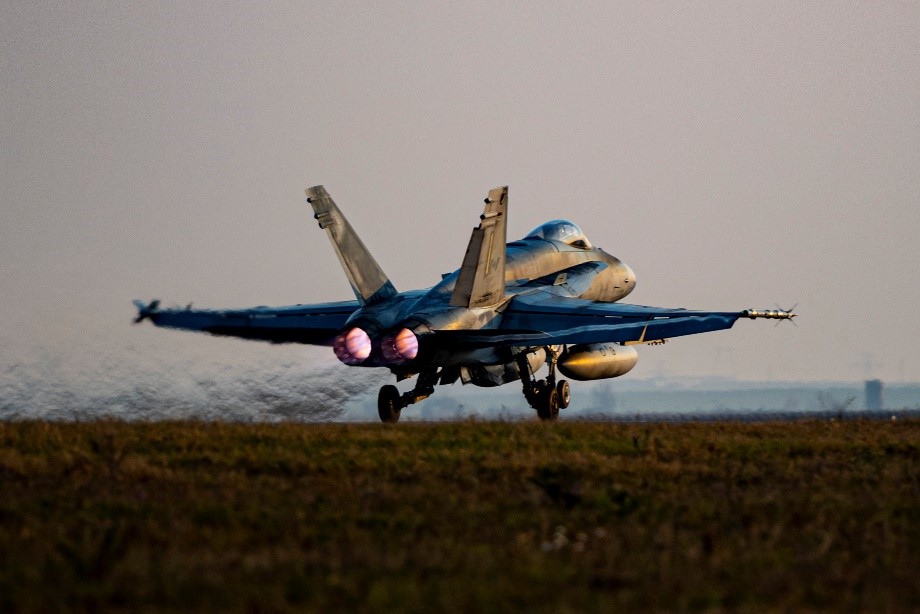
A Royal Canadian Air Force CF-18 Hornet takes off from Mihail Kogălniceanu Air Base during Operation REASSURANCE Air Task Force – Romania on 19 November 2021.
(Photo Credit: Aviator Avery Philpott, CAF photo)
National Defence will contribute to the prevention of the recruitment and use of child soldiers through implementation of the Vancouver Principles through the development of doctrine, education and training with the application of GBA Plus across all of these activities. DND/CAF will:
- Continue to work with Global Affairs Canada and the Dallaire Centre of Excellence to fully implement the Vancouver Principles on Peacekeeping and Prevention of Recruitment and use of Child Soldiers, which recognizes the importance of integrating gender perspectives when planning missions to be able to effectively prevent the recruitment and use of child soldiers. The Vancouver Principles also recognize the essential contribution of women to peacekeeping operational effectiveness, and the critical roles of men and women in the protection of children;
- Contribute academic and military educational and training expertise to emerging and partner militaries to develop professional military educational curricula and to professionalize faculty to align with NATO standards through active engagement in the NATO Defence Education Enhancement Programme; and
- Participate in international academic exchanges, including those as part of the Partnership for Peace Consortium of Defence Academies and the International Society for Military Sciences, to enhance the DND/CAF knowledge and understanding of war, conflict management, deterrence, and efforts to support peace.
The CAF remains committed to maintaining high-readiness / rapidly deployable forces in FY 2022‑23, to support the enhanced NATO Response Force and/or the NATO Response Initiative. These forces include a diverse mixture of CAF capabilities, with the intent to layer them overtop of those of our NATO partners. This allows the CAF to contribute to a more stable and peaceful world by reaffirming our commitment to promote global peace and security efforts across Europe. The CAF will continue to monitor and contribute to NATO readiness.
DND/CAF will improve the efficiency and effectiveness of Defence Intelligence through the continued implementation of the Defence Intelligence Enterprise Renewal. In particular, this strategic change management program will integrate the Defence Intelligence Enterprise across DND/CAF with ongoing pan-organization improvements and modernization of Intelligence processes, a maturing strategic-operational intelligence fusion centre, and improved linkages to our allies, other Government Departments, industry and academia. DND/CAF will evolve and expand capability development, innovation, and research and development to achieve Intelligence capability overmatch against agile adversaries.
Operation PRESENCE
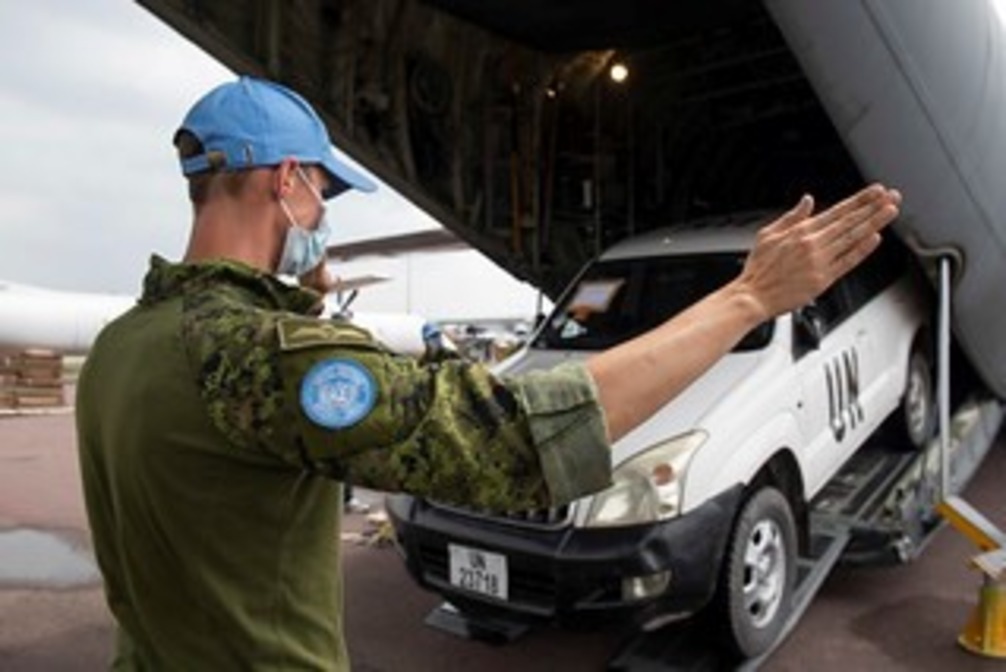
A Load Master deployed on Operation PRESENCE Uganda, Tactical Air Detachment Goma guides a United Nations vehicle toward a CC-130J Hercules aircraft at Kinshasa International Airport, Democratic Republic of the Congo on 30 November 2021.
(Photo Credit: Sergeant Vincent Carbonneau, CAF photo)
Planned results
| Departmental Results | Departmental Result Indicators | Target | Date to achieve target | 2018–19 Actual results | 2019–20 Actual results | 2020–21 Actual results |
|---|---|---|---|---|---|---|
| 1.5 Canadian Armed Forces contribute to a more stable and peaceful world | % of stated objectives met by international operations | At least 100% | 31 March 2023 | 93% | 98% | 95%* |
| Extent to which the Canadian Armed Forces is effective in international operations | The Canadian Armed Forces is effective in the conduct of international operations | 31 March 2023 | Not available qualitative indicator as of 2019-20 | This is a qualitative indicator** | This is a qualitative indicator*** |
Notes:
* Canada, in collaboration with our allies, regional partners and other Canadian government departments, continued to detect, confront and defeat trans-regional threats, including those from violent extremist organizations, before they reached our borders. This included multiple regional capacity-building initiatives with partners around the globe. The remaining 5% accounts for known capability deficiencies that prevent the CAF from fully achieving objectives. Further, due to the COVID-19 global pandemic and the high priority placed on the safety of Canadian soldiers working abroad, measures were taken to ensure their personal safety, including in some cases, repatriation. These safety measures contributed to the less than 100% target completion for the FY.
** CAF continued to provide targeted effects around the globe, enabling coalition and partner capacity building at the tactical, operational and strategic levels. Leveraging the success of both Operation UNIFIER and IMPACT, the CAF improved, and will continue to improve, capacity building and professional development training with key partners. Identified projects will address issues such as Strategic lift; contracts will fill gaps; and, exercises with partners and liaison officers will help mitigate interoperability challenges. Further described successes and challenges can be found throughout Departmental Results 1.5 of the 2019-20 Departmental Results Report.
*** The Canadian Armed Forces continued to provide effects across the globe, enabling coalition and partner capacity building at the tactical, operational and strategic levels. Work to synchronize assets and effects includes the capability to generate targeted effects within the information domain and integrating cyber enabled effects in CAF-led operations. Further described successes and challenges can be found throughout Departmental Results 1.5 of the 2020-21 Departmental Results Report.
Financial, human resources and performance information for the Department of National Defence and the Canadian Armed Forces’ Program Inventory is available in the GC InfoBase.
Planned budgetary spending for Operations
| 2022-23 budgetary spending (as indicated in Main Estimates) | 2022-23 planned spending | 2023–24 planned spending | 2024–25 planned spending |
|---|---|---|---|
| 794,902,544 | 794,902,544 | 806,647,190 | 814,971,524 |
Financial, human resources and performance information for the Department of National Defence and the Canadian Armed Forces’ Program Inventory is available in the GC InfoBase.
Planned human resources for Operations
| 2022-23 planned full-time equivalents |
2023-24 planned full-time equivalents |
2024-25 planned full-time equivalents |
|---|---|---|
| 2,144 | 2,145 | 2,151 |
Financial, human resources and performance information for the Department of National Defence and the Canadian Armed Forces’ Program Inventory is available in the GC InfoBase.